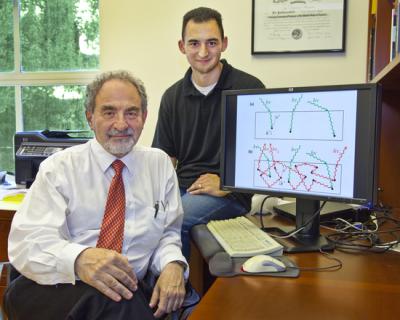Solar cells, when designed to absorb maximum light from the sun produces maximum amount of energy.
 Pictured are Eli Yablonovitch and Owen Miller, who worked out the theory for the new solar cell efficiency. The monitor in the picture illustrates the new physics concept where increased light emission yields higher efficiency. Credit: Photo courtesy Eli Yablonovitch
Pictured are Eli Yablonovitch and Owen Miller, who worked out the theory for the new solar cell efficiency. The monitor in the picture illustrates the new physics concept where increased light emission yields higher efficiency. Credit: Photo courtesy Eli Yablonovitch
The research team at University of California, Berkeley, has hypothesized as well as proved a counterintuitive concept. By designing solar cells like LEDs, both emission and absorption of light can be achieved. The research findings will be presented by the Berkeley team at the Conference on Lasers and Electro Optics, (CLEO:2012) to be held in San Jose, Calif, between May 6 and 11.
According to UC Berkeley professor of electrical engineering, Eli Yablonovitch, the high voltage and efficiency of solar cell is based on its photon emission capability. Ever since 1961, Scientists believe that around 33.5% of the incoming photons’ energy will be absorbed and transformed under ideal conditions, into beneficial electrical energy. However, in 2010, a maximum of only 26% efficiency was achieved.
A counterintuitive solution based on a thermodynamic link between light’s absorption and emission, enabled Yablonovitch and his team to design solar cells.
Based on this approach, in 2011, Alta Devices, co-founded by Yablonovitch, designed a prototype solar cell consisting gallium arsenide (GaAs). The prototype achieved 28.3% efficiency. Designing the cell to permit the light to escape enabled this high-efficiency.
The photons from the Sun strike the semiconductor material within a solar cell to produce electricity. The photons’ energy releases the electrons from this material, enabling its free-flow. This process generates luminescence.
Based on this energy concept, Yablonovitch and his team anticipate achieving 30% energy efficiency in the near future. This research work supports all types of solar cells and the findings can have significance all through this discipline.